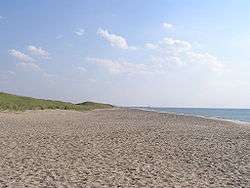HMS Defence (1763)
 HMS Defence at the Battle of the Glorious First of June 1794, dismasted and with severe injury to the hull, by Nicholas Pocock | |
| History | |
|---|---|
| Name: | HMS Defence |
| Ordered: | 15 December 1758 |
| Builder: | Plymouth Dockyard |
| Launched: | 31 March 1763 |
| Fate: | Wrecked, 24 December 1811 |
| Notes: | |
| General characteristics [1] | |
| Class and type: | Bellona-class ship of the line |
| Tons burthen: | 1603 (bm) |
| Length: | 168 ft (51.2 m) (gundeck) |
| Beam: | 46 ft 9 in (14.2 m) |
| Draught: | 21 ft 6 in (6.6 m) |
| Depth of hold: | 19 ft 9 in (6.0 m) |
| Sail plan: | Full-rigged ship |
| Armament: | |
HMS Defence was a 74-gun third-rate ship of the line of the Royal Navy, launched on 31 March 1763 at Plymouth Dockyard.[1] She was one of the most famous ships of the period, taking part in several of the most important naval battles of the French Revolutionary and Napoleonic wars. In 1811 she was wrecked off the coast of Jutland with the loss of almost her entire crew.
Service
During the American War of Independence, Defence served with the Channel Fleet, seeing action at the Battle of Cape St. Vincent in 1780. She was sent out to India in early 1782 as part of a squadron of five ships under Commodore Sir Richard Bickerton, arriving too late for the battles of that year. But in 1783 she took part in the last battle of the war, at Cuddalore. She returned to England at the end of 1785. She was then laid up during the years of peace until the outbreak of the French Revolutionary Wars.
Recommissioned into the Channel Fleet under Captain James Gambier, she fought at the Glorious First of June in 1794, distinguishing herself in action against Mucius and Tourville, and becoming one of only two British ships to be completely dismasted in the battle. After repairs, she was sent to the Mediterranean, joining Admiral William Hotham in time to take part in the Battle of Hyeres in July.
In 1798 she returned to the Mediterranean under Captain John Peyton, taking part in the Battle of the Nile in August.
On 1 July 1800, Defence, Fisgard, Renown and the hired armed cutter Lord Nelson were in Bourneuf Bay when they sent in their boats to attack a French convoy at Île de Noirmoutier.[2] The British destroyed the French ship Therese (of 20 guns), a lugger (12 guns), two schooners (6 guns each) and a cutter (6 guns), of unknown names. The cutting out party also burned some 15 merchant vessels loaded with corn and supplies for the French fleet at Brest. However, in this enterprise, 92 officers and men out of the entire party of 192 men, fell prisoners to the French when their boats became stranded. Lord Nelson had contributed no men to the attacking force and so had no casualties.[2][Note 1]
In 1801, Defence sailed to the Baltic under Captain Lord Henry Paulet with Admiral Hyde Parker's fleet. She was present at the Battle of Copenhagen, but did not see action as she was part of the reserve under Parker.
In 1805 she saw action again at the Battle of Trafalgar, where under Captain George Johnstone Hope, she captured the San Ildefonso and fought the Berwick, suffering 36 casualties.
Loss

She ran aground on 24 December 1811 off the west coast of Jutland, Denmark. She was under the command of Captain D. Atkins and in the company of St George, under Rear-admiral Robert Carthew Reynolds, and Cressy, when a hurricane and heavy seas came up.[4] St George was jury-rigged and so Atkins refused to leave her without the Admiral's permission. As a result, both were wrecked near Ringkøbing.[4] Cressy did not ask for permission and so avoided wrecking.[4]
Defence lost all but 14 of her crew of 597 men and boys, including her captain.[4] St George too lost almost her entire crew, including the admiral. Most of the bodies that came ashore were buried in the sand dunes of Thorsminde, which have been known ever since as "Dead Mens Dunes".[4]
Notes
Footnotes
Citations
References
- Gossett, William Patrick (1986). The lost ships of the Royal Navy, 1793–1900. Mansell. ISBN 0-7201-1816-6.
- Lavery, Brian (2003) The Ship of the Line – Volume 1: The development of the battlefleet 1650–1850. Conway Maritime Press. ISBN 0-85177-252-8.
External links
Coordinates: 56°21′30″N 8°06′00″E / 56.3583°N 8.1°E